外研版2017年中考一轮教材复习课件:七年级上册 Starter Modules 1-4 & Modules 1-5
文档属性
| 名称 | 外研版2017年中考一轮教材复习课件:七年级上册 Starter Modules 1-4 & Modules 1-5 |  | |
| 格式 | zip | ||
| 文件大小 | 948.5KB | ||
| 资源类型 | 教案 | ||
| 版本资源 | 外研版 | ||
| 科目 | 英语 | ||
| 更新时间 | 2017-01-25 16:24:28 | ||
图片预览

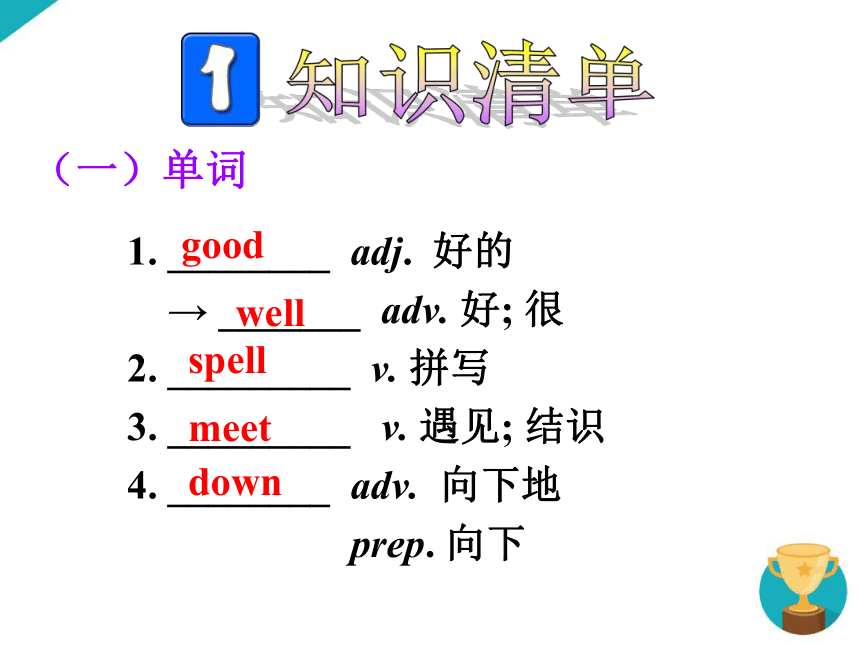
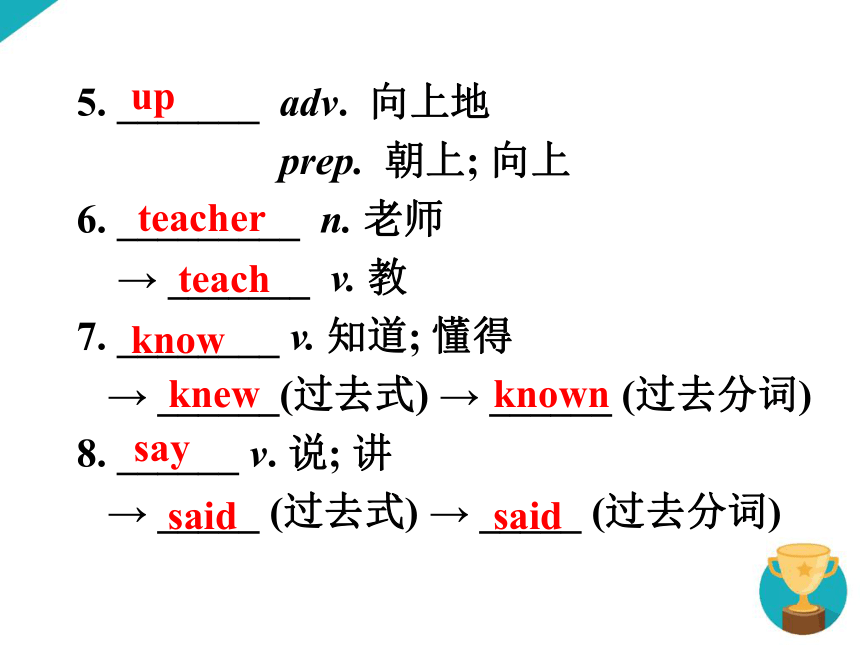
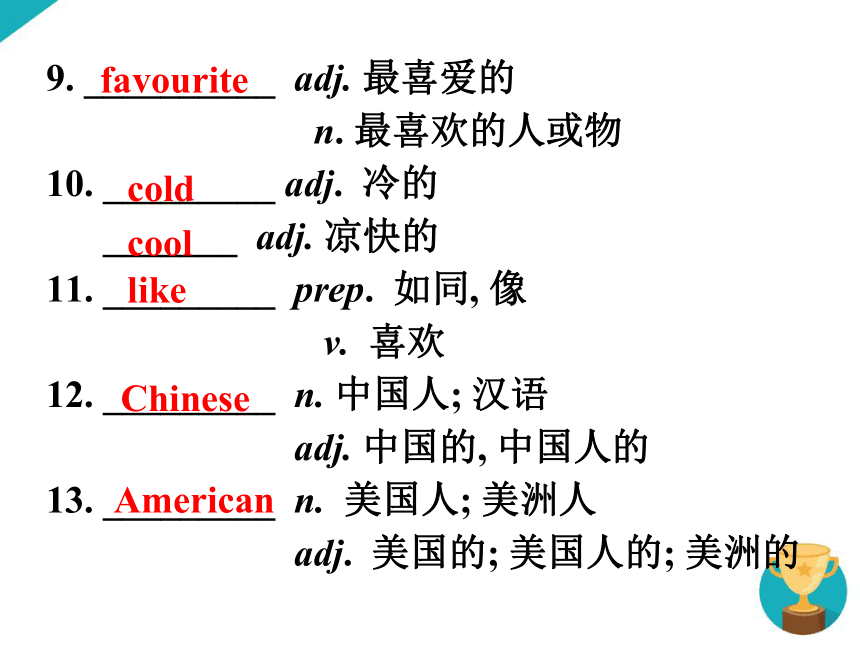
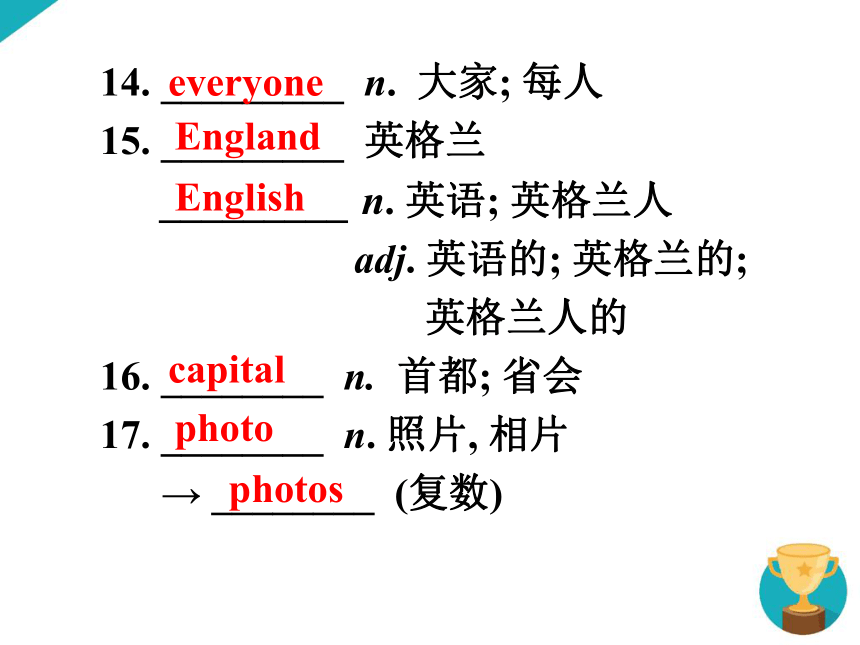
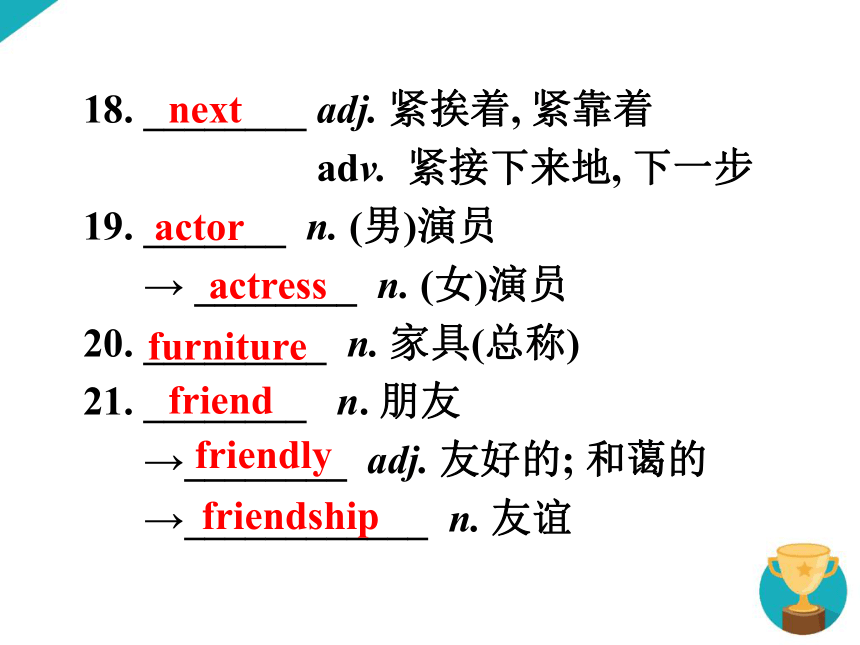
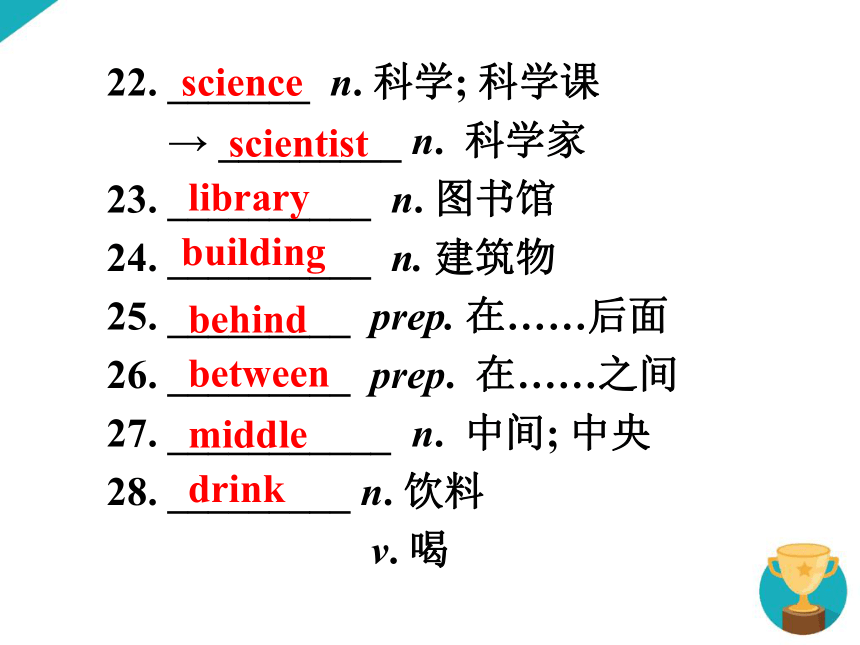
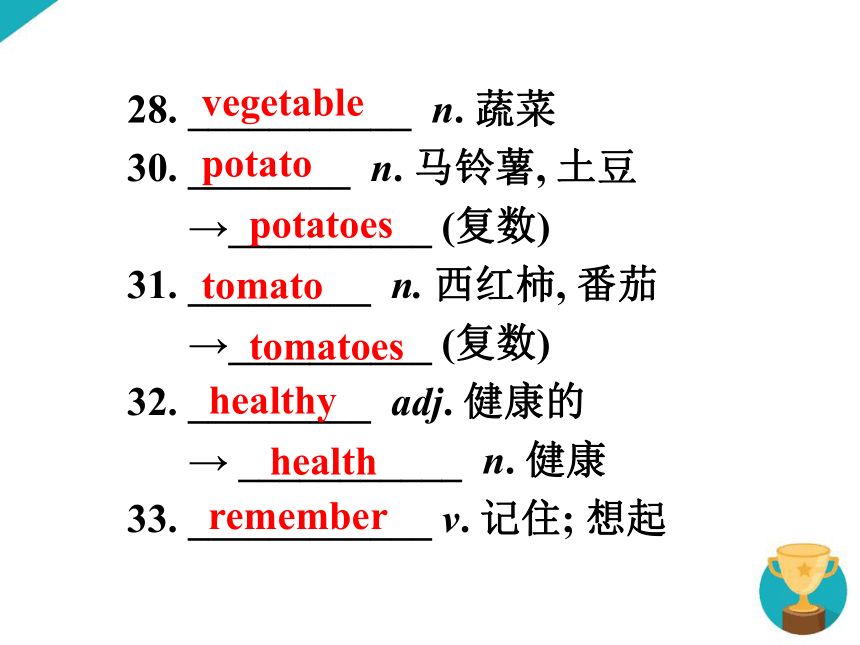
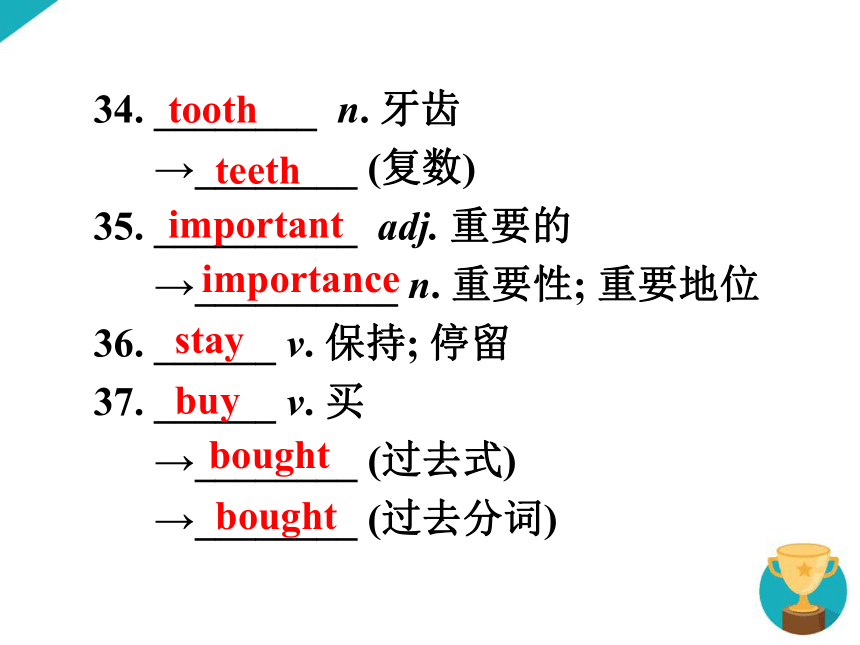
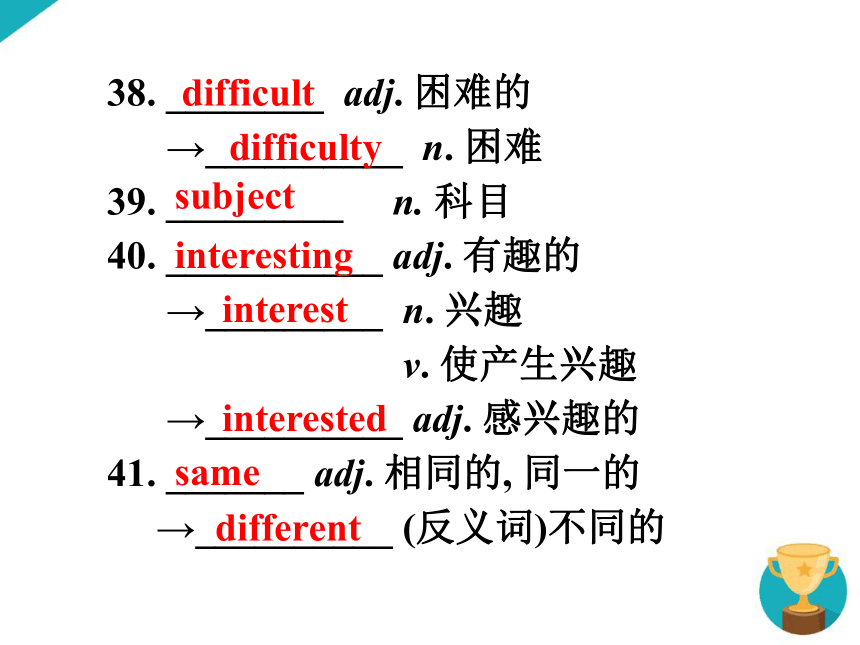
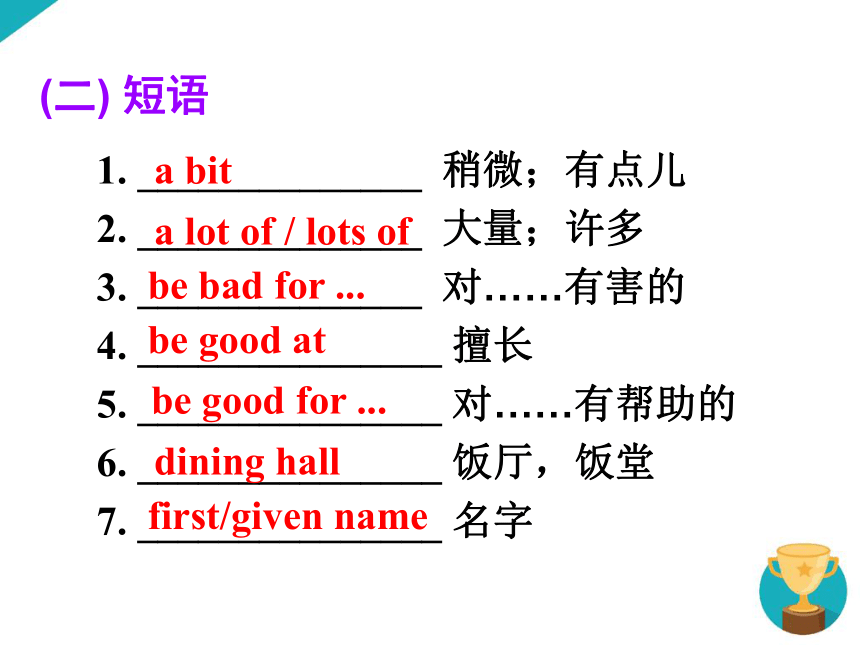
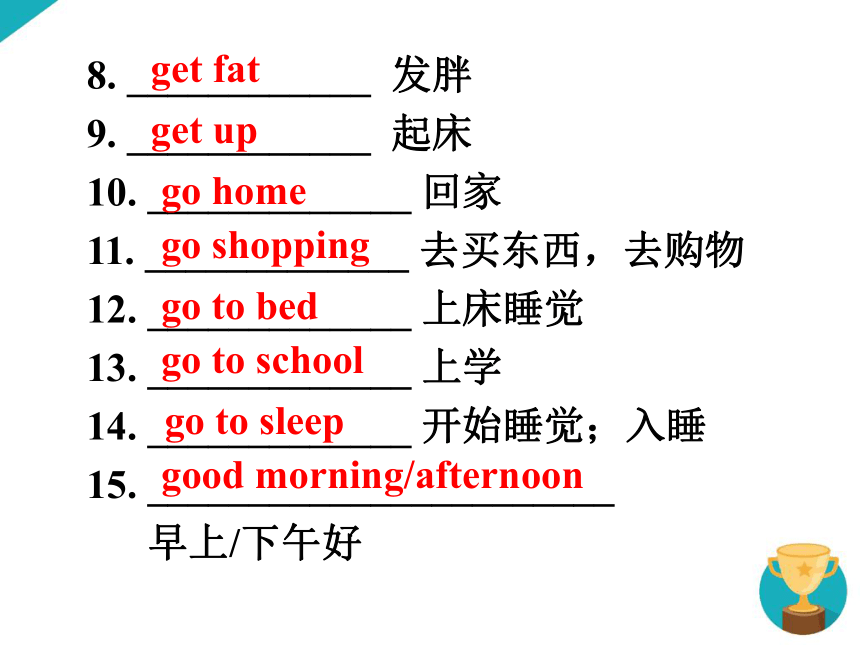
文档简介
课件76张PPT。Stater Modules 1- 4
& Modules 1-51. ________ adj. 好的
→ _______ adv. 好; 很
2. _________ v. 拼写
3. _________ v. 遇见; 结识
4. ________ adv. 向下地
prep. 向下知识清单(一)单词goodspelldownwell meet5. _______ adv. 向上地
prep. 朝上; 向上
6. _________ n. 老师
→ _______ v. 教
7. ________ v. 知道; 懂得
→ ______(过去式) → ______ (过去分词)
8. ______ v. 说; 讲
→ _____ (过去式) → _____ (过去分词)up teacherknowteachknewsaysaidsaidknown9. __________ adj. 最喜爱的
n. 最喜欢的人或物
10. _________ adj. 冷的
_______ adj. 凉快的
11. _________ prep. 如同, 像
v. 喜欢
12. _________ n. 中国人; 汉语
adj. 中国的, 中国人的
13. _________ n. 美国人; 美洲人
adj. 美国的; 美国人的; 美洲的favouritecoldcoollikeAmericanChinese14. _________ n. 大家; 每人
15. _________ 英格兰
_________ n. 英语; 英格兰人
adj. 英语的; 英格兰的;
英格兰人的
16. ________ n. 首都; 省会
17. ________ n. 照片, 相片
→ ________ (复数)everyoneEnglandcapital photophotosEnglish18. ________ adj. 紧挨着, 紧靠着
adv. 紧接下来地, 下一步
19. _______ n. (男)演员
→ ________ n. (女)演员
20. _________ n. 家具(总称)
21. ________ n. 朋友
→________ adj. 友好的; 和蔼的
→____________ n. 友谊nextactorfurniture friendfriendly friendshipactress22. _______ n. 科学; 科学课
→ _________ n. 科学家
23. __________ n. 图书馆
24. __________ n. 建筑物
25. _________ prep. 在……后面
26. _________ prep. 在……之间
27. ___________ n. 中间; 中央
28. _________ n. 饮料
v. 喝sciencescientistlibrarybuildingmiddle behindbetweendrink28. ___________ n. 蔬菜
30. ________ n. 马铃薯, 土豆
→__________ (复数)
31. _________ n. 西红柿, 番茄
→__________ (复数)
32. _________ adj. 健康的
→ ___________ n. 健康
33. ____________ v. 记住; 想起vegetablepotatotomatohealth tomatoeshealthyrememberpotatoes34. ________ n. 牙齿
→________ (复数)
35. __________ adj. 重要的
→__________ n. 重要性; 重要地位
36. ______ v. 保持; 停留
37. ______ v. 买
→________ (过去式)
→________ (过去分词)toothteethimportancebought staybuyimportantbought 38. ________ adj. 困难的
→__________ n. 困难
39. _________ n. 科目
40. ___________ adj. 有趣的
→_________ n. 兴趣
v. 使产生兴趣
→__________ adj. 感兴趣的
41. _______ adj. 相同的, 同一的
→__________ (反义词)不同的difficultdifficultyinterestinginterestedinterestsubjectsamedifferent1. ______________? 稍微;有点儿
2. ______________ 大量;许多
3. ______________? 对……有害的
4. _______________?擅长
5. _______________?对……有帮助的?
6. _______________?饭厅,饭堂
7. _______________ 名字 ?(二) 短语a bit ?a lot of / lots of? be bad for ...? be good at ?be good for ...? dining hall? first/given name 8. ____________ ?发胖
9. ____________ 起床
10. _____________ 回家
11. _____________ 去买东西,去购物??
12. _____________ 上床睡觉? ?
13. _____________ 上学
14. _____________ 开始睡觉;入睡?
15. _______________________
早上/下午好 ?get fat ??get up go to school ?go to bed go home go shopping ?go to sleep good morning/afternoon 16. _______________? (课间)休息一下?
17. ___________________________
吃早?/?午?/?晚餐
18. _______________ 用英语???
19. ________________ ?在……的前面
20. ________________ ?在……的中间???
21. ________________ ?姓
22. __________ ?在……旁边, 紧挨着……
23. __________ 是的, 当然 have a break have breakfast / lunch / dinner ?in English ?in front of ...? in the middle of ... ?last/family name? next to ... of course? 24. ______________ 在左边, 在左侧?
25. ______________ 在右边, 在右侧?
26. ______________ 坐下 ?
27. ______________ 起立 ?
28. ________________?与某人交谈
29. _____________ 太多?
30. _____________ 看电视 on the left? on the right ?sit down ?talk with / to sb.? too much ?watch TV ?sit up1. What's your number?
2. Can you say that again, please?
3. You're welcome.
4. What colour is it?
5. What day is it today?
6. What's your favourite sport?
7. Let's play football after school.??
8. Where are you from??(三)句型 9. ... what about you??
10. How old are you??
11. What a big family!??
12. These are my parents.??
13. ... what's your classroom in England like??
14. How many students are there in your class in?Beijing?
15. Is there a lot of furniture???16. Have we got any chocolate???
17. How about some orange juice??
18. We have Chinese at eight o'clock ...
19. ... we don't have maths.??
20. It's my favourite subject because it's very interesting.核心要点(一) 单词1. please int. 请 【归纳】
please是询问对方情况时常用的礼貌用语, 它可以放在句首, 也可以放在句末, 前面要有逗号和句子的其他成分隔开。2. 辨析 listen & hear
listen强调“听”的动作, 是不及物动词, 后面
不能直接跟宾语, 如果要表示“听……”时,
常与介词to连用。
hear强调“听”的结果, 是及物动词。hear
sb. do sth.表示“听见某人做了某事”, 强调
听到的动作经常发生或已经完成; ?hear sb.
doing sth.表示“听见某人正在做某事”, 强
调听到的动作正在进行。【典型例题】
根据句意用hear或?listen的适当形式填空。
1.?________! Who is talking in the room?
2. Jerry is?________?to the teacher carefully in the classroom now.
3. I could?________?Lucy playing the guitar when I walked past her house.
4. I often?_______?Miss Wu speak English.hear Listen?listening?hear?3. the art. 指已经谈到或正在谈到的事物
【归纳】
the为定冠词, 表示“这(那)个”, 常和名词连用, 表示某个或某些特定的人或事物。
常见用法:
1) 特指某人或某物。
2) 指谈话双方都知道的人或物。
3) 指世界上独一无二的事物。
4) 用于江、河、湖、海等专有名词或由
普通名词构成的专有名词前。【拓展】
不定冠词a/an的用法:
a用于以辅音音素开头的单词前。
an用于以元音音素开头的单词前。
【中考链接】
-- What’s this in English?
-- It’s _____ eraser.
A. a B. an C. the D. /
(2014 南充)4. help v. 帮助
【归纳】
常见结构:
1) help sb. (to) do sth./help sb. with sth.
帮助某人做某事
2) help (to) do sth. 帮忙去做某事5. idea n. 想法, 主意
【归纳】
idea为可数名词, 常用短语: an idea意为
“一个主意”; a good idea意为“一个好主
意”。其复数形式为ideas。
【拓展】
I have no idea. = I don’t know.
我不知道。6. like v. 喜欢; 喜爱
【归纳】
1) 后接名词或代词, 表示对某事物的兴
趣或爱好。
2) 后接v.-ing, 表示“喜欢做……”(表示习
惯性的动作)。
3) 后接动词不定式, 表示“喜欢做……”
(表示偶尔想做的事情)。7. everyone pron. 大家; 每人
【归纳】
everyone为代词, 只能用来指人, 其意 思相当于everybody。everyone作主语时, 谓语动词用第三人称单数形式。8. same adj. 相同的, 同一的
【归纳】
表示“和……一样”时, 要用“the same as”, same前要加定冠词the。表示“……和……不同”时, 用“be different from”。different前不加任何冠词。
【注意】
这两个短语表示比较, 其比较的对象必须是同类。9. furniture n. 家具(总称)
【归纳】
furniture是表示总称的物质名词, 为不可数名词, 作主语时, 谓语动词用单数形式。
【拓展】
若要表示家具的“量”, 可用much, little, a little, a lot of, lots of等修饰, 但不能用many, few, a few等修饰。10. many adj. 许多, 很多
【归纳】
many用于修饰可数名词复数, much则用于修饰不可数名词。二者均可与lots of或a lot of 互换。
how many意为“多少”, 后接可数名词复数, 用于对数量进行提问。 【中考链接】
-- ________ people travel every year?
-- Lots of people around the world.
A. How many B. How much
C. How long D. How often
(2015 临沂改编) 11. 辨析 between & among
between主要指两者之间, 其宾语往往
是表示两者的名词或代词, 或者是由
and连接的两个人或物。
among一般用于三者或三者以上, 意为
“在……之间”, 其宾语通常是一个表示
笼统数量或具有复数或集合意义的名
词或代词。【典型例题】
用among或between填空。
1) He built a house _______ the trees.
2) John runs fastest _______ the students.
3) She is sitting ________ Lucy and Lily. amongamongbetween12. for prep. 为, 为了
【归纳】
for表示某一目的, 后接名词、代词或v.-ing等。
【拓展】
for的其他用法:
1) 表示“由于; 因为”
Thank you for your help.2) 表示“供……用的”
The room is for four people.
3) 表示“向, 往”
He is leaving for Shanghai.
4) 表示“对……来说”
It’s time for me to go to school.13. remember v. 记住; 想起
【归纳】
remember to do sth. 意为“记住去做某事”, 表示事情还没有做; remember doing sth. 意为“记得做过某事”, 表示事情有已经做过了。 【中考链接】
Please remember ______ your notebook here tomorrow.
A. brings B. brought
C. bringing D. to bring
(2014 泸州)1. 辨析:in front of & in the font of
in front of 指在某个范围外部的前 面, 其反义词为behind.
in the front of 指在某个范围内部的前面, 其反义词组为at the back of。(二)短语2. 辨析: on the wall(s) & in the wall(s)
on the wall(s) 指地图、画像等悬挂、张贴于墙上, 强调外物挂在墙上。
in the wall(s) 指窗户、门、洞、孔等 镶嵌入墙内。3. a bit 稍微; 有点儿
【归纳】
用于修饰形容词或副词, 相当于a little。
【拓展】
a bit of, 意为“一点儿”, 修饰不可数名词,
相当于a little。如: a bit of water 一点儿
水。1. This is Miss Zhou.
这是周老师。
【归纳】
当把一个人介绍给另一个人时, 常用“This is…”句型, 不用“He/She is…”。
this常指代距离较近的人或物, 与其相对的词是that。它们可单独使用, 也可用来修饰名词。(三) 句式【拓展】
1) 介绍他人的句型: That is…那是…..
/This boy is…这个男孩是…… / That
girl is… 那个女孩是……
2) 当一次介绍两个或多个人时, 要用其复数形式“These are…(近指)”或“Those are…(远指)”。2. What day is it today?
今天星期几?
【归纳】
此句用来询问“今天星期几?” 是一个固定句型。其中it可以省略。常用回答为“Today is …”或“It is … today”。如:
Today is Monday. / It’s Monday. 【拓展】
如果询问“今天是几号?”则用“What’s the date today?” 如:
-- What’s the date today?
-- It’s November 25th.3. What’s the weather like in summer?
夏天的天气怎么样?
【归纳】
用来询问天气状况, 同义句是“How is the weather?”。回答常用“It’s + 描述天气的形容词(warm, hot, cool, cold…)”。4. Let’s play football after school.
我们放学后去踢足球吧。
【归纳】
1) Let’s do sth. 表示“让我们做某事吧”,
用于提出建议或征求对方的意见。其
答语常用“OK./All right./Good idea!”
等。
2) play和球类名词连用时, 中间不加冠
词。但与乐器名词连用时, 乐器名词
前要加定冠词the。【中考链接】
She likes playing _____ piano; her brother likes playing ____ basketball.
A. the; a B. a; the
C. /; the D. the; /
(2014 兰州)5. Hello, what about you?
你好, 你呢?
-- How about some orange juice?
买些橙汁好吗?
-- Yes, good idea!
嗯, 好主意!
【归纳】
What about…? 意为“……怎么样?” 相当于“How about…?”, 常用来询问他人的情况, 其后接名词、代词或动词-ing形式。6. … what’s your classroom in England like?
……在英格兰你的教室是什么样子的?
【归纳】
“What’s … like?” 句型常用来询问“……是什么样子的?”
也可以用来询问某人的性格特征。如:
-- What’s your English teacher like?
-- He is very serious.7. We have Chinese at eight o’clock and science at five to nine.
我们八点钟上语文课, 八点五十五分上科学课。
【归纳】
表示“在几点钟”应时间前加介词at。 【辨析】at, on 与 in
at常用来指具体的时间点。如:
at half past seven
on常用来指特定、具体的某一天或某一
天的上午、下午、晚上。如:
on Friday, on a rainy night
in常用来指时间段, 泛指在上午、下
午、晚上, 或在某个月份、季节、年份
等。如: in the evening, in the summer(四) 交际用语 一、问候?(Greetings)
A. Hi!
Hello!
Good morning / afternoon /evening!
How are you?
B. Hi!
Hello!
Good morning? / afternoon / evening!
I'm OK.
Very well, thank you.二、介绍?(Introduction)
A. My name is Jim.
I'm a student.
I'm from?England.
This is Mr / Mrs / Miss / Ms Brown.
B. Hello!
How do you do?
Nice / Glad to meet / see you.三、谈论天气(Talking about weather)
A. What's the weather like?
How's the weather in?Beijing?
What a cold / hot day today!
It's a nice / fine / beautiful day
today.
B. It's sunny / cloudy / windy / rainy
/ snowy.四、存在与不存在?
(Existence and non-existence)
A. Is there a map of the world?
Are there any pictures on the
classroom walls?
What's in the classroom?
B. Yes, there is / are.
No, there isn't / aren't (any).
There are many / a lot of chairs in
the classroom.指示代词this, these, that和those 语法 常用的指示代词单数有this和that,复数有these和those。
this / these:
近指。如:
This is Lisa's mobile phone.
These are their books.
指下文要提到的事。如:
Please remember this: No pains, no gains.that / those
远指。如:That's my father's computer.
Those are Susan's new books.
指前面刚刚提到过的事或用来代替上文已提到的带定冠词的名词。如:
He was ill. That was why he didn't go to school.
The machines we use today are much better than those we used ten years ago.
打电话时用this介绍自己,用that询问对方。如:This is Jerry speaking. Who's that?【典型例题】
1. — Hello, Tim speaking. Who's _______?
— Hello, this is Kelly.
A. she??? ?B. it??? ? ?C. this????? ??? D. that
2. The watches made in?Switzerland?are much
more expensive than ______ made in?China.
A. these ????????????? ? B. those??
C. ones ? ? ? ? ? ? ? ? D. themThere be?结构
一、句型结构
“There be +主语(某人或某物) +状语(某地或某时)”表示“某地或某时有某人或某物”。
二、动词be的形式
1.?时态的变化
There be结构有时态的变化。
一般现在时:There is / are ...?如:
There is a ruler on the desk.一般过去时:There was / were ...?如:
There were many birds in our garden yesterday.
一般将来时:There is / are going to / will be ...?如:
There is going to / will be a basketball game in our school this afternoon.
现在完成时:There has / have been ... 如:
There have been thousands of people in the stadium.2.?数的变化
当只有一个主语时,动词be在数上应与其后的主语保持一致,即语法一致原则。如:
There were two men in the store at that time.
There is an orange on the table.
当主语为并列主语时,可以根据第一个主语的单复数来确定be的形式,即就近一致原则;也可以根据语法一致的原则来确定be的形式。如:
There is / are a cup and two bowls on the table.【中考链接】
I. 单项选择。
1. — _________ there any living things on other planets?
— I have no idea. Maybe we can know more about that in the future.
A. Is?? ???? ? B. Are?? ??C. Has???? ? D. Have???
?(2015?广东)2.?— Shall we hang out in Great Bazzar (大巴扎) tomorrow?
— I’m afraid not. _________ the final game of the World Cup on TV.
A. There is ? ? ? ? ? ? ?
B. There will be???
C. There will have?? ?
D. There is going to have???
?(2015?新疆乌鲁木齐)II. 连词成句(注意词形变化)。
interesting activity, many, there were
?(2015?河北)
There were many interesting activities. I. 根据语境及所给首字母提示, 补全所缺单词。
1. Peter is a friendly boy. We like h____ very much.
2. There are seven days in a w_____.
3. I'm very b____. I have no time to play sports.him?巩固练习weekbusy? 4. This desk is too s______. I want a big
one.
5.?Alice?is my aunt. Her daughter is my
c______.
6. They usually have breakfast at half
p____ six in the morning.
7. E________ in my family likes table
tennis.Everyonesmall?cousin?past?8. Susan often goes swimming w____ her mother at weekends. They enjoy it.
9.?Beijing?is a big city and it's the c_______ of?China.
10. This sport is r______ interesting.
We all like it.really? withcapital??Ⅱ.?根据上句完成下句, 使两句意思相同或相近, 每空一词(含缩略形式)。
1. Is your friend from?Hefei?
Does your friend ______ ______?Hefei?
2. Eating lots of chocolate isn't good for
you.
Eating lots of chocolate is ____ ____ you. bad for come from3. Sam plays football very well.
Sam is _____ ____ playing football.
4. He is Li Kai.
_____ ______ is Li Kai.
5. Bob is in my school.
Bob and I are in _____ ______ school.
6. We go to school from Monday to Friday.
We go to school ____ __________.
7. How is the weather in spring here????
_______ the weather _____ in spring here?the same ?good at??His name? on weekdays?? What's like III. 对下列句子中的划线部分进行提问, 每
空一词。
1. Sam is?thirteen years old.
_____ _______ is Sam?
2. The boy is?my brother.
______ _____ the boy?
3. My aunt is?a nurse.
_______ does your aunt _____?What do How old?Who is??4. There are?six?girls in the room.
______ _______ girls are there in
the room?
5. We have Chinese?at nine o'clock.
______ ________ do you have
Chinese?
6. It is?Thursday?today.?
________ ________ is it today?What day? How manyWhat time?7. Our school is?very big.
________ is your school ______?
8. The bananas are?yellow.
________ ________ are the
bananas?What colour What likeIV. 根据括号内所给英文提示语将下列句
子翻译成英语。
1.?这个蓝色的包怎么样??(what about)
What about this blue bag?
2.?我们学校紧挨着车站。?(next to)
Our school is next to the station.
3.?他想要许多胡萝卜。?(a lot of)
He wants a lot of carrots.4.?他通常几点钟入睡??(go to sleep)
What time does he usually go to sleep?
5.?这位女士不想变胖。?(get fat)
This woman doesn't want to get fat.
6.?现在我感觉有点累。?(a bit)
I feel a bit tired now.7.?他有一支红色的铅笔。?(have got)
He has got a red pencil.
8.?你不能喝太多的可乐。? (too much)
You can't drink too much cola.
& Modules 1-51. ________ adj. 好的
→ _______ adv. 好; 很
2. _________ v. 拼写
3. _________ v. 遇见; 结识
4. ________ adv. 向下地
prep. 向下知识清单(一)单词goodspelldownwell meet5. _______ adv. 向上地
prep. 朝上; 向上
6. _________ n. 老师
→ _______ v. 教
7. ________ v. 知道; 懂得
→ ______(过去式) → ______ (过去分词)
8. ______ v. 说; 讲
→ _____ (过去式) → _____ (过去分词)up teacherknowteachknewsaysaidsaidknown9. __________ adj. 最喜爱的
n. 最喜欢的人或物
10. _________ adj. 冷的
_______ adj. 凉快的
11. _________ prep. 如同, 像
v. 喜欢
12. _________ n. 中国人; 汉语
adj. 中国的, 中国人的
13. _________ n. 美国人; 美洲人
adj. 美国的; 美国人的; 美洲的favouritecoldcoollikeAmericanChinese14. _________ n. 大家; 每人
15. _________ 英格兰
_________ n. 英语; 英格兰人
adj. 英语的; 英格兰的;
英格兰人的
16. ________ n. 首都; 省会
17. ________ n. 照片, 相片
→ ________ (复数)everyoneEnglandcapital photophotosEnglish18. ________ adj. 紧挨着, 紧靠着
adv. 紧接下来地, 下一步
19. _______ n. (男)演员
→ ________ n. (女)演员
20. _________ n. 家具(总称)
21. ________ n. 朋友
→________ adj. 友好的; 和蔼的
→____________ n. 友谊nextactorfurniture friendfriendly friendshipactress22. _______ n. 科学; 科学课
→ _________ n. 科学家
23. __________ n. 图书馆
24. __________ n. 建筑物
25. _________ prep. 在……后面
26. _________ prep. 在……之间
27. ___________ n. 中间; 中央
28. _________ n. 饮料
v. 喝sciencescientistlibrarybuildingmiddle behindbetweendrink28. ___________ n. 蔬菜
30. ________ n. 马铃薯, 土豆
→__________ (复数)
31. _________ n. 西红柿, 番茄
→__________ (复数)
32. _________ adj. 健康的
→ ___________ n. 健康
33. ____________ v. 记住; 想起vegetablepotatotomatohealth tomatoeshealthyrememberpotatoes34. ________ n. 牙齿
→________ (复数)
35. __________ adj. 重要的
→__________ n. 重要性; 重要地位
36. ______ v. 保持; 停留
37. ______ v. 买
→________ (过去式)
→________ (过去分词)toothteethimportancebought staybuyimportantbought 38. ________ adj. 困难的
→__________ n. 困难
39. _________ n. 科目
40. ___________ adj. 有趣的
→_________ n. 兴趣
v. 使产生兴趣
→__________ adj. 感兴趣的
41. _______ adj. 相同的, 同一的
→__________ (反义词)不同的difficultdifficultyinterestinginterestedinterestsubjectsamedifferent1. ______________? 稍微;有点儿
2. ______________ 大量;许多
3. ______________? 对……有害的
4. _______________?擅长
5. _______________?对……有帮助的?
6. _______________?饭厅,饭堂
7. _______________ 名字 ?(二) 短语a bit ?a lot of / lots of? be bad for ...? be good at ?be good for ...? dining hall? first/given name 8. ____________ ?发胖
9. ____________ 起床
10. _____________ 回家
11. _____________ 去买东西,去购物??
12. _____________ 上床睡觉? ?
13. _____________ 上学
14. _____________ 开始睡觉;入睡?
15. _______________________
早上/下午好 ?get fat ??get up go to school ?go to bed go home go shopping ?go to sleep good morning/afternoon 16. _______________? (课间)休息一下?
17. ___________________________
吃早?/?午?/?晚餐
18. _______________ 用英语???
19. ________________ ?在……的前面
20. ________________ ?在……的中间???
21. ________________ ?姓
22. __________ ?在……旁边, 紧挨着……
23. __________ 是的, 当然 have a break have breakfast / lunch / dinner ?in English ?in front of ...? in the middle of ... ?last/family name? next to ... of course? 24. ______________ 在左边, 在左侧?
25. ______________ 在右边, 在右侧?
26. ______________ 坐下 ?
27. ______________ 起立 ?
28. ________________?与某人交谈
29. _____________ 太多?
30. _____________ 看电视 on the left? on the right ?sit down ?talk with / to sb.? too much ?watch TV ?sit up1. What's your number?
2. Can you say that again, please?
3. You're welcome.
4. What colour is it?
5. What day is it today?
6. What's your favourite sport?
7. Let's play football after school.??
8. Where are you from??(三)句型 9. ... what about you??
10. How old are you??
11. What a big family!??
12. These are my parents.??
13. ... what's your classroom in England like??
14. How many students are there in your class in?Beijing?
15. Is there a lot of furniture???16. Have we got any chocolate???
17. How about some orange juice??
18. We have Chinese at eight o'clock ...
19. ... we don't have maths.??
20. It's my favourite subject because it's very interesting.核心要点(一) 单词1. please int. 请 【归纳】
please是询问对方情况时常用的礼貌用语, 它可以放在句首, 也可以放在句末, 前面要有逗号和句子的其他成分隔开。2. 辨析 listen & hear
listen强调“听”的动作, 是不及物动词, 后面
不能直接跟宾语, 如果要表示“听……”时,
常与介词to连用。
hear强调“听”的结果, 是及物动词。hear
sb. do sth.表示“听见某人做了某事”, 强调
听到的动作经常发生或已经完成; ?hear sb.
doing sth.表示“听见某人正在做某事”, 强
调听到的动作正在进行。【典型例题】
根据句意用hear或?listen的适当形式填空。
1.?________! Who is talking in the room?
2. Jerry is?________?to the teacher carefully in the classroom now.
3. I could?________?Lucy playing the guitar when I walked past her house.
4. I often?_______?Miss Wu speak English.hear Listen?listening?hear?3. the art. 指已经谈到或正在谈到的事物
【归纳】
the为定冠词, 表示“这(那)个”, 常和名词连用, 表示某个或某些特定的人或事物。
常见用法:
1) 特指某人或某物。
2) 指谈话双方都知道的人或物。
3) 指世界上独一无二的事物。
4) 用于江、河、湖、海等专有名词或由
普通名词构成的专有名词前。【拓展】
不定冠词a/an的用法:
a用于以辅音音素开头的单词前。
an用于以元音音素开头的单词前。
【中考链接】
-- What’s this in English?
-- It’s _____ eraser.
A. a B. an C. the D. /
(2014 南充)4. help v. 帮助
【归纳】
常见结构:
1) help sb. (to) do sth./help sb. with sth.
帮助某人做某事
2) help (to) do sth. 帮忙去做某事5. idea n. 想法, 主意
【归纳】
idea为可数名词, 常用短语: an idea意为
“一个主意”; a good idea意为“一个好主
意”。其复数形式为ideas。
【拓展】
I have no idea. = I don’t know.
我不知道。6. like v. 喜欢; 喜爱
【归纳】
1) 后接名词或代词, 表示对某事物的兴
趣或爱好。
2) 后接v.-ing, 表示“喜欢做……”(表示习
惯性的动作)。
3) 后接动词不定式, 表示“喜欢做……”
(表示偶尔想做的事情)。7. everyone pron. 大家; 每人
【归纳】
everyone为代词, 只能用来指人, 其意 思相当于everybody。everyone作主语时, 谓语动词用第三人称单数形式。8. same adj. 相同的, 同一的
【归纳】
表示“和……一样”时, 要用“the same as”, same前要加定冠词the。表示“……和……不同”时, 用“be different from”。different前不加任何冠词。
【注意】
这两个短语表示比较, 其比较的对象必须是同类。9. furniture n. 家具(总称)
【归纳】
furniture是表示总称的物质名词, 为不可数名词, 作主语时, 谓语动词用单数形式。
【拓展】
若要表示家具的“量”, 可用much, little, a little, a lot of, lots of等修饰, 但不能用many, few, a few等修饰。10. many adj. 许多, 很多
【归纳】
many用于修饰可数名词复数, much则用于修饰不可数名词。二者均可与lots of或a lot of 互换。
how many意为“多少”, 后接可数名词复数, 用于对数量进行提问。 【中考链接】
-- ________ people travel every year?
-- Lots of people around the world.
A. How many B. How much
C. How long D. How often
(2015 临沂改编) 11. 辨析 between & among
between主要指两者之间, 其宾语往往
是表示两者的名词或代词, 或者是由
and连接的两个人或物。
among一般用于三者或三者以上, 意为
“在……之间”, 其宾语通常是一个表示
笼统数量或具有复数或集合意义的名
词或代词。【典型例题】
用among或between填空。
1) He built a house _______ the trees.
2) John runs fastest _______ the students.
3) She is sitting ________ Lucy and Lily. amongamongbetween12. for prep. 为, 为了
【归纳】
for表示某一目的, 后接名词、代词或v.-ing等。
【拓展】
for的其他用法:
1) 表示“由于; 因为”
Thank you for your help.2) 表示“供……用的”
The room is for four people.
3) 表示“向, 往”
He is leaving for Shanghai.
4) 表示“对……来说”
It’s time for me to go to school.13. remember v. 记住; 想起
【归纳】
remember to do sth. 意为“记住去做某事”, 表示事情还没有做; remember doing sth. 意为“记得做过某事”, 表示事情有已经做过了。 【中考链接】
Please remember ______ your notebook here tomorrow.
A. brings B. brought
C. bringing D. to bring
(2014 泸州)1. 辨析:in front of & in the font of
in front of 指在某个范围外部的前 面, 其反义词为behind.
in the front of 指在某个范围内部的前面, 其反义词组为at the back of。(二)短语2. 辨析: on the wall(s) & in the wall(s)
on the wall(s) 指地图、画像等悬挂、张贴于墙上, 强调外物挂在墙上。
in the wall(s) 指窗户、门、洞、孔等 镶嵌入墙内。3. a bit 稍微; 有点儿
【归纳】
用于修饰形容词或副词, 相当于a little。
【拓展】
a bit of, 意为“一点儿”, 修饰不可数名词,
相当于a little。如: a bit of water 一点儿
水。1. This is Miss Zhou.
这是周老师。
【归纳】
当把一个人介绍给另一个人时, 常用“This is…”句型, 不用“He/She is…”。
this常指代距离较近的人或物, 与其相对的词是that。它们可单独使用, 也可用来修饰名词。(三) 句式【拓展】
1) 介绍他人的句型: That is…那是…..
/This boy is…这个男孩是…… / That
girl is… 那个女孩是……
2) 当一次介绍两个或多个人时, 要用其复数形式“These are…(近指)”或“Those are…(远指)”。2. What day is it today?
今天星期几?
【归纳】
此句用来询问“今天星期几?” 是一个固定句型。其中it可以省略。常用回答为“Today is …”或“It is … today”。如:
Today is Monday. / It’s Monday. 【拓展】
如果询问“今天是几号?”则用“What’s the date today?” 如:
-- What’s the date today?
-- It’s November 25th.3. What’s the weather like in summer?
夏天的天气怎么样?
【归纳】
用来询问天气状况, 同义句是“How is the weather?”。回答常用“It’s + 描述天气的形容词(warm, hot, cool, cold…)”。4. Let’s play football after school.
我们放学后去踢足球吧。
【归纳】
1) Let’s do sth. 表示“让我们做某事吧”,
用于提出建议或征求对方的意见。其
答语常用“OK./All right./Good idea!”
等。
2) play和球类名词连用时, 中间不加冠
词。但与乐器名词连用时, 乐器名词
前要加定冠词the。【中考链接】
She likes playing _____ piano; her brother likes playing ____ basketball.
A. the; a B. a; the
C. /; the D. the; /
(2014 兰州)5. Hello, what about you?
你好, 你呢?
-- How about some orange juice?
买些橙汁好吗?
-- Yes, good idea!
嗯, 好主意!
【归纳】
What about…? 意为“……怎么样?” 相当于“How about…?”, 常用来询问他人的情况, 其后接名词、代词或动词-ing形式。6. … what’s your classroom in England like?
……在英格兰你的教室是什么样子的?
【归纳】
“What’s … like?” 句型常用来询问“……是什么样子的?”
也可以用来询问某人的性格特征。如:
-- What’s your English teacher like?
-- He is very serious.7. We have Chinese at eight o’clock and science at five to nine.
我们八点钟上语文课, 八点五十五分上科学课。
【归纳】
表示“在几点钟”应时间前加介词at。 【辨析】at, on 与 in
at常用来指具体的时间点。如:
at half past seven
on常用来指特定、具体的某一天或某一
天的上午、下午、晚上。如:
on Friday, on a rainy night
in常用来指时间段, 泛指在上午、下
午、晚上, 或在某个月份、季节、年份
等。如: in the evening, in the summer(四) 交际用语 一、问候?(Greetings)
A. Hi!
Hello!
Good morning / afternoon /evening!
How are you?
B. Hi!
Hello!
Good morning? / afternoon / evening!
I'm OK.
Very well, thank you.二、介绍?(Introduction)
A. My name is Jim.
I'm a student.
I'm from?England.
This is Mr / Mrs / Miss / Ms Brown.
B. Hello!
How do you do?
Nice / Glad to meet / see you.三、谈论天气(Talking about weather)
A. What's the weather like?
How's the weather in?Beijing?
What a cold / hot day today!
It's a nice / fine / beautiful day
today.
B. It's sunny / cloudy / windy / rainy
/ snowy.四、存在与不存在?
(Existence and non-existence)
A. Is there a map of the world?
Are there any pictures on the
classroom walls?
What's in the classroom?
B. Yes, there is / are.
No, there isn't / aren't (any).
There are many / a lot of chairs in
the classroom.指示代词this, these, that和those 语法 常用的指示代词单数有this和that,复数有these和those。
this / these:
近指。如:
This is Lisa's mobile phone.
These are their books.
指下文要提到的事。如:
Please remember this: No pains, no gains.that / those
远指。如:That's my father's computer.
Those are Susan's new books.
指前面刚刚提到过的事或用来代替上文已提到的带定冠词的名词。如:
He was ill. That was why he didn't go to school.
The machines we use today are much better than those we used ten years ago.
打电话时用this介绍自己,用that询问对方。如:This is Jerry speaking. Who's that?【典型例题】
1. — Hello, Tim speaking. Who's _______?
— Hello, this is Kelly.
A. she??? ?B. it??? ? ?C. this????? ??? D. that
2. The watches made in?Switzerland?are much
more expensive than ______ made in?China.
A. these ????????????? ? B. those??
C. ones ? ? ? ? ? ? ? ? D. themThere be?结构
一、句型结构
“There be +主语(某人或某物) +状语(某地或某时)”表示“某地或某时有某人或某物”。
二、动词be的形式
1.?时态的变化
There be结构有时态的变化。
一般现在时:There is / are ...?如:
There is a ruler on the desk.一般过去时:There was / were ...?如:
There were many birds in our garden yesterday.
一般将来时:There is / are going to / will be ...?如:
There is going to / will be a basketball game in our school this afternoon.
现在完成时:There has / have been ... 如:
There have been thousands of people in the stadium.2.?数的变化
当只有一个主语时,动词be在数上应与其后的主语保持一致,即语法一致原则。如:
There were two men in the store at that time.
There is an orange on the table.
当主语为并列主语时,可以根据第一个主语的单复数来确定be的形式,即就近一致原则;也可以根据语法一致的原则来确定be的形式。如:
There is / are a cup and two bowls on the table.【中考链接】
I. 单项选择。
1. — _________ there any living things on other planets?
— I have no idea. Maybe we can know more about that in the future.
A. Is?? ???? ? B. Are?? ??C. Has???? ? D. Have???
?(2015?广东)2.?— Shall we hang out in Great Bazzar (大巴扎) tomorrow?
— I’m afraid not. _________ the final game of the World Cup on TV.
A. There is ? ? ? ? ? ? ?
B. There will be???
C. There will have?? ?
D. There is going to have???
?(2015?新疆乌鲁木齐)II. 连词成句(注意词形变化)。
interesting activity, many, there were
?(2015?河北)
There were many interesting activities. I. 根据语境及所给首字母提示, 补全所缺单词。
1. Peter is a friendly boy. We like h____ very much.
2. There are seven days in a w_____.
3. I'm very b____. I have no time to play sports.him?巩固练习weekbusy? 4. This desk is too s______. I want a big
one.
5.?Alice?is my aunt. Her daughter is my
c______.
6. They usually have breakfast at half
p____ six in the morning.
7. E________ in my family likes table
tennis.Everyonesmall?cousin?past?8. Susan often goes swimming w____ her mother at weekends. They enjoy it.
9.?Beijing?is a big city and it's the c_______ of?China.
10. This sport is r______ interesting.
We all like it.really? withcapital??Ⅱ.?根据上句完成下句, 使两句意思相同或相近, 每空一词(含缩略形式)。
1. Is your friend from?Hefei?
Does your friend ______ ______?Hefei?
2. Eating lots of chocolate isn't good for
you.
Eating lots of chocolate is ____ ____ you. bad for come from3. Sam plays football very well.
Sam is _____ ____ playing football.
4. He is Li Kai.
_____ ______ is Li Kai.
5. Bob is in my school.
Bob and I are in _____ ______ school.
6. We go to school from Monday to Friday.
We go to school ____ __________.
7. How is the weather in spring here????
_______ the weather _____ in spring here?the same ?good at??His name? on weekdays?? What's like III. 对下列句子中的划线部分进行提问, 每
空一词。
1. Sam is?thirteen years old.
_____ _______ is Sam?
2. The boy is?my brother.
______ _____ the boy?
3. My aunt is?a nurse.
_______ does your aunt _____?What do How old?Who is??4. There are?six?girls in the room.
______ _______ girls are there in
the room?
5. We have Chinese?at nine o'clock.
______ ________ do you have
Chinese?
6. It is?Thursday?today.?
________ ________ is it today?What day? How manyWhat time?7. Our school is?very big.
________ is your school ______?
8. The bananas are?yellow.
________ ________ are the
bananas?What colour What likeIV. 根据括号内所给英文提示语将下列句
子翻译成英语。
1.?这个蓝色的包怎么样??(what about)
What about this blue bag?
2.?我们学校紧挨着车站。?(next to)
Our school is next to the station.
3.?他想要许多胡萝卜。?(a lot of)
He wants a lot of carrots.4.?他通常几点钟入睡??(go to sleep)
What time does he usually go to sleep?
5.?这位女士不想变胖。?(get fat)
This woman doesn't want to get fat.
6.?现在我感觉有点累。?(a bit)
I feel a bit tired now.7.?他有一支红色的铅笔。?(have got)
He has got a red pencil.
8.?你不能喝太多的可乐。? (too much)
You can't drink too much cola.
